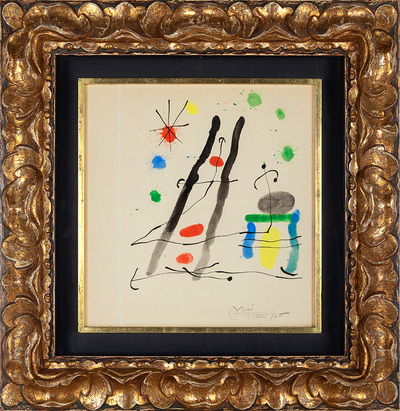Joan Miró: spirituality and transgression
Joan Miró: spirituality and transgression
The watercolor made in 1965, up for auction next March 8, brings us closer to the irresistible magnetism of the Miró universe
Recognized as one of the great universal geniuses of contemporary art, Joan Miró was above all an artist committed to his time and to his particular vision of the creative act, whose essence remained unchanged. The radically introspective character of the artist and his reticence before any artistic dogma, placed a young Miró in no man’s land who, far from bowing down to the attacks he received and giving in to any passing fad, remained firm in his conviction that achieve a universal art that with its own voice would express that substantial and eternal that starts from the depths of our roots .
In an exercise in transgression, Miró rejected the classical idea of painting, which, as he used to say, had been in decline since the Altamira cave, in order to recover that original and essential underlying prehistoric art. Although it is true that his work stems from multiple influences such as Romanesque art, Dadaism or Cubism, for Miró the beauty he found in the small treasures he collected from his walks through the fields and beaches was infinitely more inspiring, where elements a priori as insignificant as a stone, a handful of sand or an ant that took him back to the origins of that Mediterranean land he longed for so much.
From this breeding ground was born an immense creator of poetic spaces and visual whims in which, as in this case, each element, sign, shape and color, sustained under the emptiness of the support, achieve a surprising and magical harmony. Experimenting and playing with all kinds of supports and techniques, paper was for him one of the mediums in which he felt most comfortable and where his need to find a plastic language that translates the pure and genuine that tangible reality hides . In this sense, the watercolor in question is a more than eloquent example of the function that Miró attributed to art, understood as a means through which to transcend reality, to ascend towards a superior spiritual world.
Under this concept, the staircase, will be a recurring motif throughout its entire trajectory, which, as in this case, will symbolize a link between the earth and the sky, a bridge between the earthly and the supernatural that embodies the desire and the need to escape. However, Miró knew how to transform all that anguish into an oneiric world, where his characteristic archaic symbols and the use of shapes and primary colors give us back that ingenuity and spontaneity of our childhood. With minimal resources, Miró managed to achieve an expressive intensity where, behind the apparent simplicity, hides the essence of an artist who sought in art the lost purity of a torn world.
On a certain occasion, Miró said that the words that poets invent are doors to a new world. Something similar happens with his work. Thanks to Miró we learned a new way of observing and being in the world that has transcended time like an immense oasis to which we go in search of a place to take refuge.







